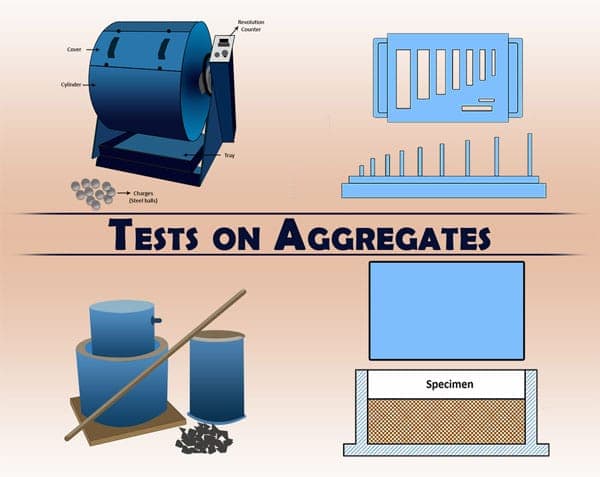
Nowadays, with the rapid urbanization and growth in population, the construction industry is booming, and hence the demand for high-rise buildings is displaying an upward trend. This development in building construction has led to an increase in demand for better performing building/construction materials such as high strength concrete and its components like cement, sand, and aggregates. For long-lasting performance, each and every building material should be checked for their desired properties include durability.
Maintaining top quality is of utmost importance in the present times. Due to this emphasis on quality, construction has to satisfy pre-decided benchmarks and standards. For aggregates, 7 important tests are identified which determine the quality of aggregate.
In this article we explore the importance of aggregate testing, various tests on aggregates and all the important properties of aggregates. Aggregate is one of the primary building materials and constituent of concrete. Aggregates are used in construction and include sand, gravel, crushed stone, slag, recycled concrete etc. If this topic is related to your college studies, domyhomework123 may come in handy.
Why is it Necessary to Test Aggregates?
According to ‘Prof. Dr. B. Bhattacharjee’ (Professor of Indian Institute of Technology, Delhi), aggregate is the second most important ingredient which forms the skeleton for concrete. Aggregates influence, to a greater extent, the load transfer capability of pavements and slabs.
Therefore, before using for construction, it is necessary that they should be completely tested. Not only the aggregates should be strong and durable, but they should also have proper shape and size to make the element slab/pavement act monolithically. Hence, it is important to perform the tests on aggregates to ensure the quality of aggregates and check the properties of aggregate.
The aggregates are tested to determine their properties like,
- Strength
- Toughness
- Hardness
- Shape
- Water Absorption etc.
Following are the different types of aggregate tests conducted to ascertain the suitability of aggregates:
01. Crushing Test on Aggregates
02. Abrasion Test on Aggregates
03. Impact Test on Aggregates
04. Soundness Test on Aggregates
05. Shape Test on Aggregates
06. Specific Gravity and Water Absorption Test on Aggregates
07. Bitumen Adhesion Test on Aggregates
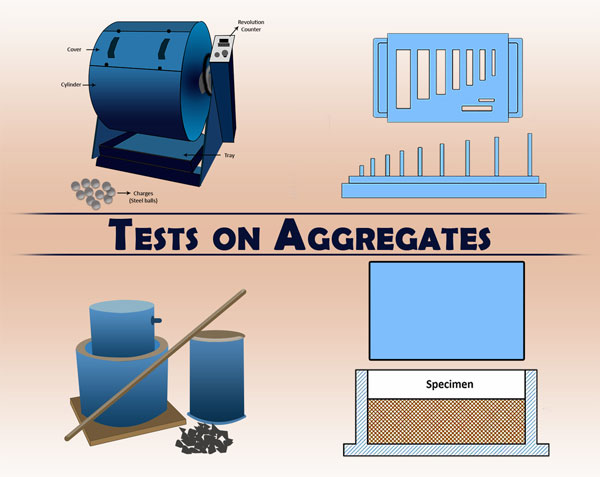
Various Types of Tests on Aggregates
In order to decide the suitability of the aggregate for using in concrete/pavement construction, following tests are carried out:
01. Crushing Test on Aggregates
In order to decide the suitability of the aggregate for using in concrete/pavement construction, following tests are carried out:
(a) Importance of Crushing Test:
The aggregate crushing value test indicates the strength of aggregate which is the most essential property of coarse aggregate. The aggregate crushing value provides a relative measure of resistance to crushing under a gradually applied compressive load.
For achieving a high quality of pavement, aggregate of higher crushing strength i.e. low crushing value should be preferred. Lower crushing value means higher strength as it indicates a lower crushed fraction under load. This gives a longer service life and a more economical performance.
(b) Recommended Result of Crushing Test:
If the aggregate crushing value is less than 10, it signifies an exceptionally strong aggregate. Whereas, if the crushing value is 35 or above, it would normally be considered as weak aggregate.
After performing the test, the crushed material is separated and calculated in terms of percentage of the original weight taken in the mould. This percentage is known as a crushing value of aggregate. This percentage should not exceed 30% of the total weight of aggregate taken for the test.
The aggregate crushing value test result should not be more than 30 % for the concrete used for roads and pavements and, in case of other structures; it may be permitted up to 45%.
(c) Standard Guidelines for Crushing Test:
Followings are the standard guidelines for the crushing test on aggregates:
- IS 2386(Part 4):1963
- BS 812–110:1990
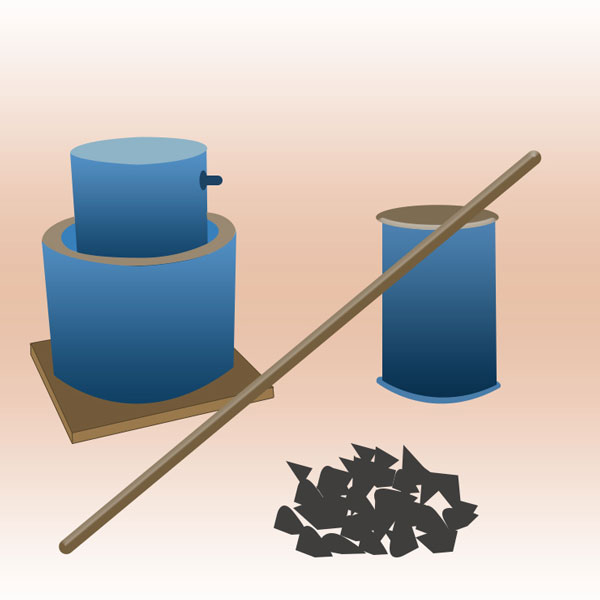
Crushing Mould for Aggregates Test Image
(d) Apparatus of Crushing Test:
- Compressive Testing Machine
- Crushing Mould: A steel cylinder 15 cm diameter with plunger and base plate.
- Weighing machine,
- Sieve: Size of 12.5 mm, 10 mm and 2.36 mm
The crushing mould is filled in three layers with aggregates. Then the weight (W1) of the aggregate in the crushing mould is noted. After that, the mould is placed in the compression testing machine and loaded at gradually applied load so that it reaches a load of 40 tons in 10 minutes.
The load is then released and the aggregates are then removed from the mould. Aggregates are then sieved through a 2.36 mm sieve and weight (W2) is measured. The crushing value of aggregates is calculated as (W1/W2) *100 and value is expressed in %.
To access detailed information about this aspect, you can read,
02. Abrasion Test on Aggregates
This test is carried out to determine the abrasion value of the coarse aggregate. The principle of the Los Angeles abrasion test is to find the percentage wear due to relative rubbing action between the aggregate and steel balls used as an abrasive charge.
(a) Importance of Abrasion Test:
Abrasion test on aggregate indicates the hardness of aggregate. It shows the ability of aggregate to resist wear and tear.
(b) Recommended Result of Abrasion Test:
Abrasion value of aggregate should not be more than 30 percent for aggregate used for surface wearing course and, should not be more than 45 percent for surface other than wearing course.
(c) Standard Guidelines for Abrasion Test:
Followings are the standard guidelines for the abrasion test on aggregates:
- IS 2386(Part 4):1963
- BS 812-113:1990
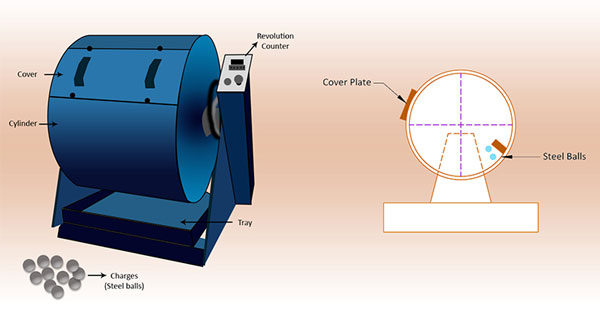
Abrasion Testing Machine Image
(d) Apparatus of Abrasion Test:
- Los Angles Abrasion Machine
- Steel balls: 11no.
- Weighing balance
- Sieves: 20, 12.5, 10, 1.7mm
The Los Angeles abrasion testing machine consists of a circular drum mounted on a horizontal axis; so that, it can be rotated. The steel balls are placed in the drum along with the sample of aggregates. The drum is then rotated for a total of 500 to 1000 revolutions at a speed of 30 to 33 rpm (revolution per minute) depending upon the gradation of aggregates. After rotation, the material is sieved through a 1.7 mm sieve and the difference between the initial weight and the final weight (sieved weight) is calculated. The result is expressed as %, and this value is called Abrasion value of aggregate.
To know more in detail, read the,
03. Impact Test on Aggregates
Aggregate may be subjected to a sudden shock or impact during as well as after the construction. These loads are different from the gradually applied compressive loads. Due to such kind of loads, aggregate breaks down into smaller pieces. In order to evaluate the resistance to impact of aggregate, the aggregate impact test is conducted. Aggregate impact value gives the idea about how much impact load can be resisted by aggregate. Actually, aggregate should be sufficiently tough to resist their disintegration due to impact. This distinctive property is measured by impact value test.
(a) Importance of Impact Test:
Impact test on aggregates indicates the toughness of aggregate. It shows the ability of aggregate to resist the sudden shock or impact.
(b) Recommended Result of Impact Test:
Aggregate impact value is the same as the abrasion test result. Impact value of aggregate should not exceed 30 percent for aggregate used for surface wearing course and should not exceed 45 percent for surface other than wearing course.
(c) Standard Guideline for Impact Test:
Followings are the standard guidelines for the impact test on aggregate:
- IS 2386(Part 4):1963
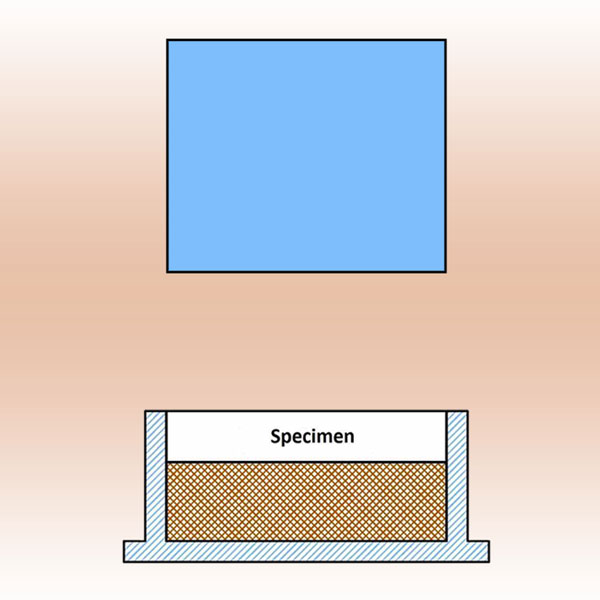
Impact Test Apparatus Image
(d) Apparatus of Impact Test:
- Aggregate impact apparatus,
- IS sieves (12.5 mm, 10.0 mm and 2.36 mm),
- Cylindrical measure and cylindrical cup,
- Weighing balance,
- Tamping rod.
Take a sample of aggregate passing through a 12.5 mm sieve and retained on a 10 mm sieve. Fill the sieved aggregates in a cylindrical cup. Place the mould in the aggregate impact testing machine and administer 15 numbers of blows of a metal hammer. After that, remove the crushed aggregate and sieve it through a 2.36 mm sieve. The aggregate impact value is measured as % of aggregates passing through the 2.36mm sieve (W2) to the total weight of the sample (W1).
To know more in detail read,
04. Soundness Test on Aggregates
Soundness test on aggregate is conducted to understand the resistance of aggregates to weathering action. Aggregates are subjected to the physical and chemical action of rain-water, groundwater and the other impurities of the atmosphere. This can lead to a change in the volume which is not good and substandard for the durability of construction. The property of aggregates to withstand the adverse action of weather is known as soundness of aggregate.
(a) Importance of Soundness Test:
Soundness test on aggregates indicates the durability of aggregates. It shows the ability of aggregates to resist the adverse effect of weather. The soundness test is carried out to learn the resistance of aggregates to weathering actions like thawing, freezing, alternate wetting and drying in normal condition and, variation in temperature in salt water. When aggregates fail to resist such conditions, then it said to be unsound.
(b) Recommended Result of Soundness Test:
Recommended result of soundness test should not more than 12 % and 18 % after 10 cycles when tested with sodium sulphate and magnesium sulphate respectively.
(c) Standard Guidelines for Soundness Test:
Followings are the standard guidelines for the soundness test on aggregates:
- IS 2386 (Part 5):1963
- BS 812-121:1989
(d) Apparatus of Soundness Test:
- Sodium Sulphate or Magnesium Sulphate Solution,
- Oven,
- Weighing Balance,
- IS Sieves,
- Weight Balance.
Take a sample of well-graded aggregate and weight it. Immerse aggregate sample into the solution of sodium sulphate or magnesium sulphate for 16 to 18 hours. After immersion, place the aggregates in the oven for drying. Repeat this cycle several times according to requirement and then measure the loss in weight.
To know more in detail read,
05. Shape Test on Aggregates
Aggregates are available in various sizes and shapes, i.e. rounded, cubical, and angular flaky or elongated. It is proved that the flaky and elongated particles have less strength, less bonding, less interlocking and durability as compared with cubical, angular or rounded particles of the same size aggregates. It can be said that aggregates are flaky when aggregates are too thin compared to their average size (mean dimension). Elongated aggregate means aggregates they are too long compared to their average size (mean dimension). Flakiness index test and elongation index test are performed to find flaky and elongated aggregates.
(a) Importance of Shape Test:
Flakiness index test and elongation index test are used to determine the shape of the aggregate. It is defined in percentage by weight of aggregate particles to the mean dimension of thickness and length of it.
(b) Recommended Result of Shape Test:
Recommended result of shape test of aggregates should be in range of 15% to 30% according to the area of use.
(c) Standard Guidelines for Shape Test:
Followings are the standard guidelines for the shape test on aggregates:
- IS 2386(Part 1):1963
- BS 812-105.1:1989
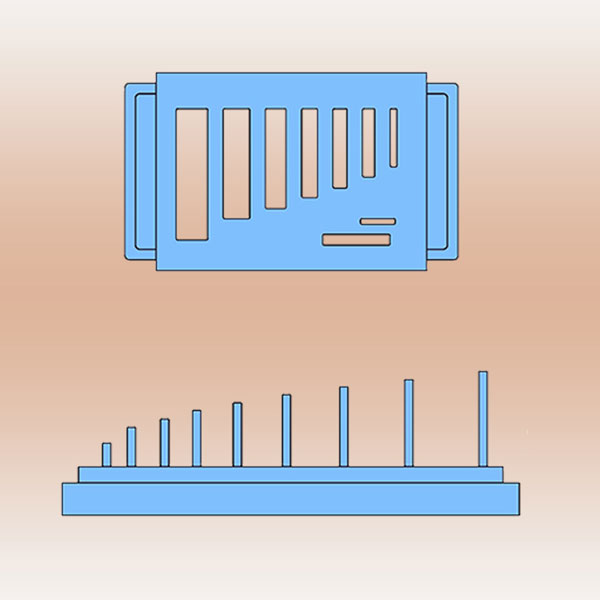
Shape/Flakiness Index Apparatus for Aggregates Test Image
(d) Apparatus of Shape Test:
- Thickness gauge
- Length gauge
- Weighing balance
- IS Sieves
Take an aggregate sample of around 200 pieces of any fraction and weight it. Gauge each aggregate on length as well as thickness gauge. Take the weight of the aggregates which are retained from length gauge to find the elongation index and take the weight of the aggregates which passes through the thickness gauge to find the flakiness index. Calculate the percentage of aggregates passing and the initial weight. It’s called the elongation index and calculate the percentage of retained aggregates and the initial weight. This will give the flakiness index.
To know more read,
06. Specific Gravity and Water Absorption Test on Aggregates
Specific gravity of aggregate is defined as the ratio of the weight of aggregate to the weight of equal volume of water. It shows the strength of aggregate. Aggregates having a low specific gravity are generally weaker than those with having high specific gravity.
Water absorption of aggregate gives an idea about the internal structure of aggregate. If aggregates have more absorption capacity, they are called porous in nature. Such aggregates are unsuitable and generally not preferred for any construction.
(a) Importance of Specific Gravity and Water Absorption:
The specific gravity and water absorption test on aggregates measures strength or quality of the aggregate. This property helps in general identification of aggregates.
(b) Recommended Result of Test:
The specific gravity of aggregates generally used in construction ranges from about 2.5 to 3.0 and water absorption ranges from about 0.1 % to 2.0 %
(c) Standard Guidelines for Test:
Followings are the standard guidelines for the specific gravity and water absorption test on aggregates:
- IS 2386(Part 3):1963
- BS 812-2:1995
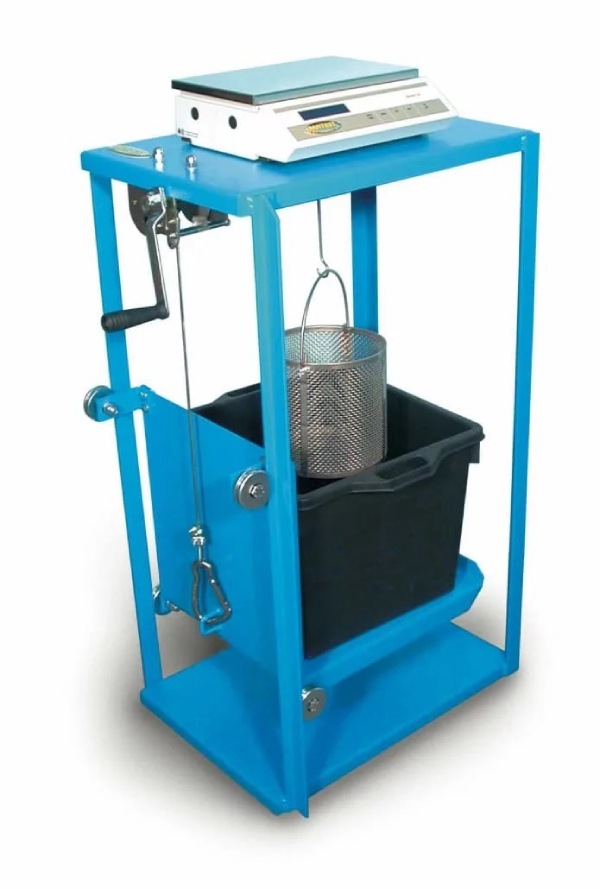
Apparatus for Specific Gravity and Water Absorption Test of Coarse Aggregate
(d) Apparatus of Test:
- Density basket,
- Weighing balance,
- Water tank,
- Tray,
- IS sieves- 10mm and 20mm.
Take a sample of aggregates of 2kg. Place the aggregates in a wire basket and immerse it in distilled water for 24 hours. Then, take the weight of aggregates and basket in water as A1. After that, remove the basket and aggregates from water and take the weight of basket suspended in water as A2.
Dry those aggregates with a dry cloth and then take the weight of these dry aggregates, and denote it as B. Next, place the aggregates in the oven for 24 hours and measure the weight of oven-dried aggregates as C.
Now calculate, Specific gravity= C/(B-A) and water absorption = 100 (B-C)/C according to this formula.
To know more read,
07. Bitumen Adhesion Test on Aggregates
Bitumen gets well bonded to all the normal types of road aggregates provided they are dry and free from dust. In the absence of water, there is no adhesion problem in bituminous construction. Adhesion problem arises when the aggregate is wet and cold. This problem can be dealt with by removing moisture from the aggregate by drying and increasing the mixing temperature.
For finding bitumen adhesion, the stripping value test is conducted. Stripping value of aggregates is determined as the ratio of the uncovered area observed visually to the total area of aggregates which is ultimately expressed in percentage.
(a) Importance of Bitumen Adhesion Test:
Bitumen adhesion test on aggregates determines the adhesion of bituminous binder to aggregate in the presence of water.
(b) Recommended Result of Bitumen Adhesion Test:
Recommended result (stripping value) of bitumen adhesion test should not exceed 5 percent.
(c) Standard Guideline for Bitumen Adhesion Test:
Followings are the standard guidelines for the bitumen adhesion test on aggregates:
- IS:6241- 1971
(d) Apparatus of Bitumen Adhesion Test:
- Water Bath,
- Oven,
- Sieve,
- Mixer to mix aggregate and bitumen.
Take a sample of 200 gm of dry aggregates passing a 20mm sieve and retained on 12.5mm sieve and 5 % by weight of bitumen binder. Mix the binder and the aggregates till they are fully coated. Then transfer the mixture into a 500ml beaker and allow to cool at room temperature for about 2 hours. Next, add distilled water and immerse the coated aggregates. Cover the beaker and keep in a water bath for 24 hours. Now take the beaker out and let it cool at room temperature. The uncovered area needs to be observed visually.
Reasons for the Failure of Tests on Aggregate (All Tests Mentioned Above) & Some Suggestions to Deal with them
If aggregate tests results are not in the range of recommendations, there can be many reasons like weak or poor aggregates, error in the testing procedure, error in the test appliance etc. If any of tests on aggregates fail first of all, ensure that there is no error in the test appliance or the procedure. If that seems to be the likely reason, the aggregates should be retested.
However, if the test appliances are in order, test procedures are followed religiously, and yet the test result have failed; it is advisable not to use those aggregate for structural as well as for non-structural purpose.
To understand importance of all the test, it becomes necessary to understand all the properties of aggregates. So, let’s take a look at all the important properties of aggregates as mentioned below.
The Important Properties of Aggregates
01. Strength of Aggregate
The coarse aggregates to be used in construction should be sufficiently strong to withstand the loads because; it is the prime construction material in the building as well as pavement. According to ‘A. M. Neville’ (Honorary member of the American Concrete Institute and author of Properties of Concrete), the strength and elasticity of aggregate depend on its composition, density, texture and structure. For a high-quality pavement, the aggregate should possess high resistance to crushing, and to withstand the stresses due to traffic load.
02. Hardness of Aggregate
When the aggregates are used in the surface course, they are subjected to constant rubbing or abrasion due to the constant movements of traffic on the pavement. Hence, they must be hard enough to resist the wear and tear occurring due to the abrasive action of traffic load. The abrasive action is severe over the aggregate exposed on the top surface. Not much but some amount of abrasion may be induced due to the friction between particles of aggregate in concrete.
03. Toughness of Aggregate
According to ‘M.S. Shetty’ (Author of Concrete Technology Theory and Practice), toughness is the resistance of the aggregates to impact. Aggregates used in the construction of buildings and pavements are also subjected to impact due to sudden load in buildings and moving wheel loads on pavements. Hence, the resistance to impact is the desirable property of aggregates.
04. Durability of Aggregate
The property of aggregate to withstand the adverse action of weather and other chemical reactions can be termed as soundness. The aggregate used in the construction of buildings and pavements should be durable i.e. it should have long life and should resist disintegration due to the weather action. The aggregates are subjected to various physical and chemical reactions of rain water, soil, water percolated in ground and many other impurities. Hence, aggregate must be sound enough to withstand such reactions as well as the weathering action.
05. Shape of Aggregate
According to ‘Zongjin Li’ (Author of Advanced Concrete Technology), shape of aggregate affects the workability of fresh concrete. Because the differences in the surface area caused by different shapes, will determine cement paste required to coat the aggregate, to provide lubrication and increase workability.
Apart from workability of concrete, shape of aggregate is also an essential property of aggregate because it also plays a significant role in the strengthen, grading and interlocking of aggregate with each other, which is ultimately responsible for toughness and firmness.
Aggregates happen to fall in different shapes i.e. round, angular, cubical, flaky or elongated. It is evident that aggregates with round, angular, cubical shapes are more durable and sustainable as compared to flaky and elongated ones.
Also Read:
Shape Wise Classification of Aggregate
Size Wise Classification of Aggregate
06. Alkali-Aggregate Reaction
As per the ‘Fournier, B & Berube, M’ (2011) (Published in: Alkali-aggregate reaction in concrete: A review of basic concepts and engineering implications), the alkali-aggregate reaction is the chemical reaction that occurs in the concrete which can produce the premature distress and loss in serviceability thereby, affecting concrete structures.
In other words, alkali-aggregate reaction is the expansive reaction that takes place between alkali and elements within an aggregate which can result in pattern cracking, surface pop outs and break off into fragments if it is severe enough. There are two types of alkali- aggregate reaction occurring,
01. Alkali-Silica Reaction (ASR)
02. Alkali-Carbonate Reaction (ACR)
Generally, aggregates are the chemically inert, but if the active silica or carbonate is present in the aggregate, it reacts with the alkalis present in the cement paste, causing expansion and cracking over a period of time.
07. Specific Gravity of Aggregate
The specific gravity and water absorption of aggregates are important properties for designing concrete and bituminous mixes. Specific gravity of an aggregate is the ratio of the weight of a given volume of aggregate to the weight of an equal volume of water. It is a quality measure and determines the strength of aggregate.
08. Adhesion with Bitumen
The aggregates used in bituminous pavements must have less affection for water as compared with bituminous material; otherwise, the bituminous coating of the aggregates will get stripped off in presence of water. In absence of water or moisture, there is no problem in bituminous construction.
We hope, the information that we have provided regarding properties of aggregate and tests on aggregates should help you in making a wise and rational selection of aggregates. This article highlights the various quality of aggregates, thereby helping you to make a right choice and instill confidence in you about the longevity of your house.
This article further provides information as to why and when to conduct test on aggregates, which tests you need to perform and why? It emphasizes under which circumstances the aggregates should be rejected and also offers some suggestions in order to overcome the problem.
The best recommendation that we can come up with is – Aggregates are important for the strength and longevity of the structure, hence, do not ignore these tests. Mostly all tests need to be performed in laboratory. There are, however, some field tests also which can be performed on-site to determine the suitability of aggregates. Never avoid such tests as the life and strength of your structure depends on them.
We have also created an infographic, which compiles this article and is easy for you to save. Please click on the link below:
https://gharpedia.com/infographic/tests-on-aggregate/
Also Read:
Classification of Aggregates According to Nature of Formation
What are the Advantages of Using Maximum Sized Aggregate in Concrete?
Recycled Concrete Aggregates: Its Properties & Uses
Image Courtesy: Image 6





































